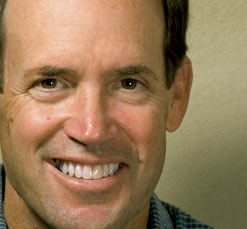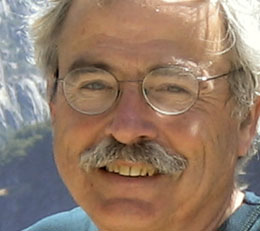Volume 26 · Number 3 · Spring 2009
Informed Dissent
Sometimes, what research uncovers isn’t what the world wants to hear.
Judith Stern champions the rights of the extremely obese.
Jeffrey Mount and Peter Moyle’s ideas about water can anger nearly everybody.
James Carey disputes the California Department of Food and Agriculture’s response to the light brown apple moth.
Norm Matloff opposes increasing the numbers of visas for foreign computer programmers and engineers.
Nicole Biggart reminds everyone annually that Fortune 500 companies lack women in their boardrooms and executive suites.
Consternation. Ire. Frustration. Contention. Meet a half-dozen UC Davis faculty members whose research and expertise have conflicted with conventional wisdom, usually appearing in the form of lawmakers, representatives of business and industry, or activist citizens’ groups. They get their names in the paper, their faces on television and on YouTube. Why do they do it? Because it’s at the heart of UC Davis’ land-grant mandate — to conduct research in the public interest and share the results with California’s citizens.
“We are by nature contrarians here,” says geology professor Jeffrey Mount. “We are trained as academics to challenge conventional wisdom. We’re scientists, so what do scientists do but try to reject hypotheses? Conventional wisdom can be viewed as a hypothesis; we go out and beat on conventional wisdom, and if it survives, great! If it doesn’t, greater!”
The public benefits too, said Bob Powell, professor of chemical engineering and materials science and chair of the UC Davis Academic Senate. “That this sort of work occurs at the University of California, Davis, speaks to the core values of the faculty and the university’s commitment to freedom of inquiry,” Powell said. “These faculty members all represent the best of what UC Davis has to offer in terms of research, teaching and our commitment of service to society.”
Jeffrey Mount and Peter Moyle: Water Fights
When the subject is water, all of California wades in. Some parts of the state have it, other parts need it and fish and other species depend on it. Determining the best way to divvy it up is a task that would give even Solomon pause. Mount and Peter Moyle dive right in. Mount is director of the UC Davis Center for Watershed Sciences; his colleague Moyle is a professor of fish biology and one of the center’s associate directors. Together, the two have been involved in numerous water research projects, and their findings have not always been what those on the receiving end have wanted to hear.

Jeffrey Mount
Unlike academicians who devote their careers to conducting basic research, Mount, Moyle and their colleagues at Watershed Sciences are engaged in applied research, directed at solving pressing and immediate problems. And there’s no shortage of water-related issues in California: “A target-rich environment is the best way to describe it,” Mount says. And one of the biggest targets around is the Sacramento–San Joaquin Delta, where two of California’s largest rivers meet, creating the West Coast’s largest estuary. Comprising small towns, farmland, industry, highways and marinas, the Delta is at the hub of California’s water distribution system; roughly two-thirds of the state’s residents and millions of acres of irrigated farmland rely on the Delta for water.
Mount and Moyle are two of the authors of the Public Policy Institute of California’s 2008 report “Comparing Futures for the Sacramento–San Joaquin Delta.” (Four of the report’s other five authors are also affiliated with UC Davis: Civil and Environmental Engineering Professor Jay Lund, also and associate director of the Center for Watershed Sciences; Richard Howlett, professor and chair of agricultural and resource economics; William Fleenor, a research engineer in civil and environmental engineering; and William Bennet, a researcher in fish ecology.) The report concluded that “building a peripheral canal to carry water around the Delta is the most promising way” to both revive that threatened ecosystem and ensure a reliable water supply for the state.
There are so many players in the Delta drama. Sellers and buyers of water and water users vie with environmental groups that point out that fish and other species need water, too; farmers and residents of the Delta’s low-lying islands fear changes in the system will threaten their livelihoods and lifestyles; elected officials worry that an earthquake or Katrina-like flood could wreak havoc on the state’s water supplies, devastating the agricultural economy and costing billions of dollars.
Because Mount and Moyle were among the many who opposed a peripheral canal project proposed back in 1982 (and which was soundly rejected by voters), Mount says some constituencies view his turnaround as a betrayal. But he emphasizes that although the report recommends that a peripheral canal be built, “we recommend building it only in the context of trying to meet a policy objective . . . coequal value of water supply and ecosystem. And we just can’t see how you’re going to do it any other way.”

Peter Moyle
Moyle has studied that ecosystem, specifically the Delta smelt, since the 1970s when he was an assistant professor of fisheries. “I was looking for things I could study that would result in fairly easy publication,” he says. His book Inland Fishes of California was published in 1976, and its account of the Delta smelt was “really short,” simply because no one knew anything about the fish. “I said, ‘Oh, this is a good one for me to work on,’” says Moyle, who in a few years became the foremost expert on a tiny fish that’s a huge indicator of the health of the Delta ecosystem.
When over the course of a decade or so he realized that the species had gone from being one of the Delta’s most abundant fish to being scarce, Moyle felt he had to speak up. “This seemed like a no-brainer,” he says. “This is a species that occurs only in the San Francisco estuary, it has a one-year life cycle, it clearly needs special attention to save it. And since I’m the expert on this fish, it’s sort of my duty to tell everybody that this is a problem,” That meant, to Moyle, that the fish needed to be listed by the California Fish and Game Commission as a threatened species. The commission disagreed, saying there simply wasn’t enough information about it to make a determination. (The Department of Fish and Game’s latest survey, which concluded in December, indicated that the Delta smelt is at its lowest point in 42 years of record-keeping.)
Moyle’s disappointment at the outcome was eased somewhat when he discovered that “people really wanted to talk to me about Delta issues. It raised my profile as an expert in that area.” (The fish subsequently was listed as threatened under the federal Endangered Species Act in 1993.) And from Moyle’s perspective, media coverage of his testimony before legislative committees or as an expert witness in court trials is a good thing. “It’s allowed me to attract good graduate students,” he says, typically students who want to end up working for state or federal resource agencies or environmental organizations, who want to be involved in decision-making and resource protection. “It’s well known that I like to have students who will be actively involved, and they, of course, are attracted to me because they know I am,” he says, laughing. “They know I can advise them somewhat on the pitfalls of being involved.”
That said, even Moyle admits that throughout this whole Delta smelt process, there have been times when he wondered what he’s gotten himself into. Should he really be doing this?
